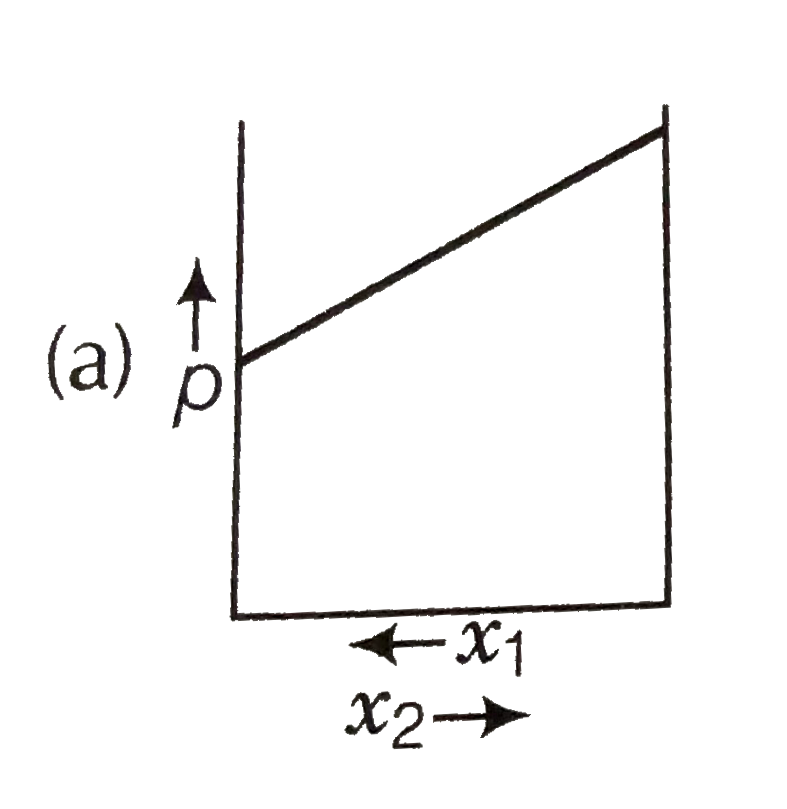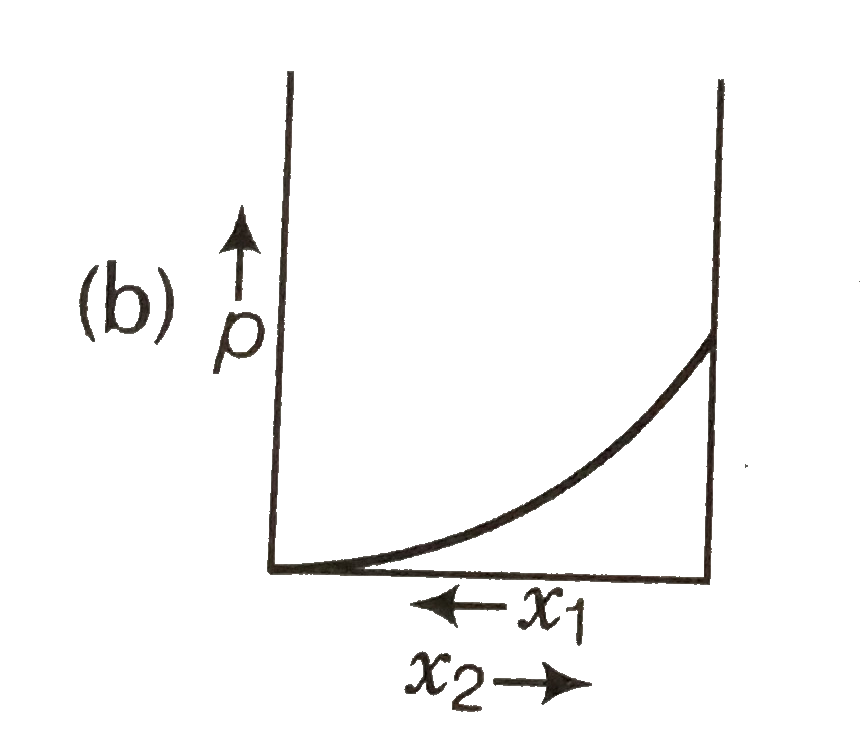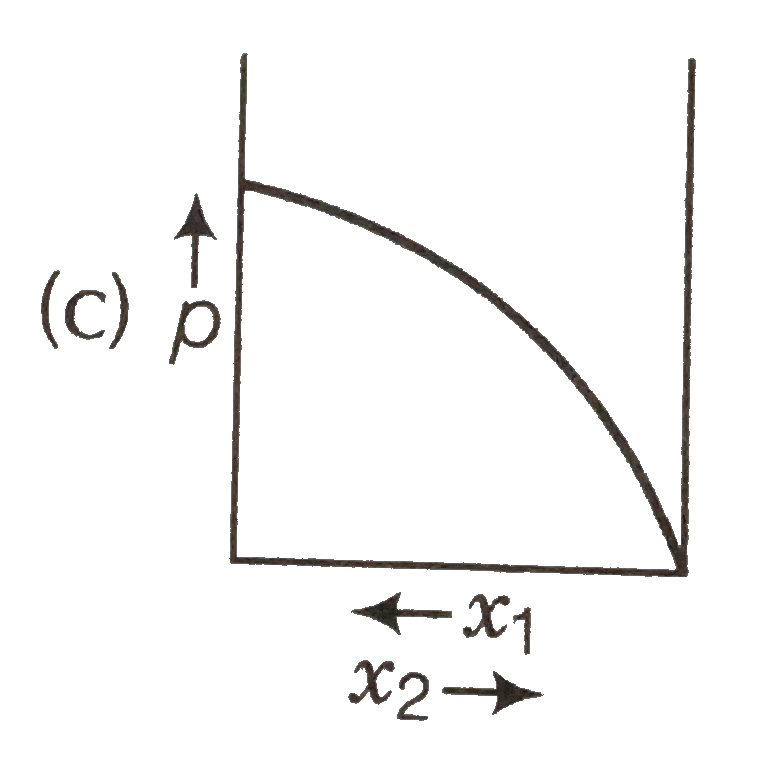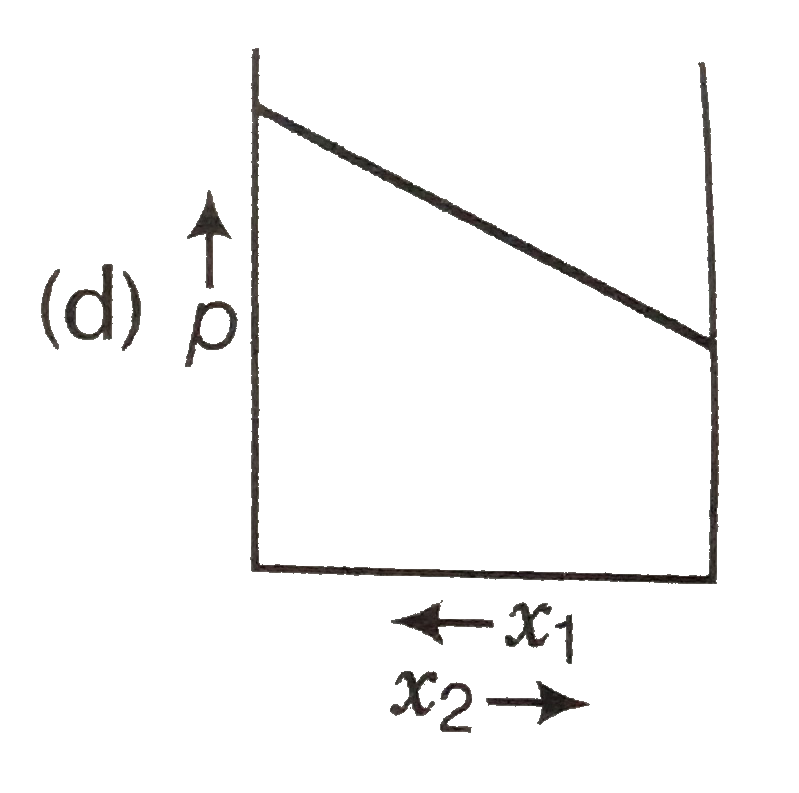For a binary ideal liquid solution, the variation total vapour pressure versus composition of solution is given by which of the curves?




The correct Answer is:A, D
To determine the variation of total vapor pressure versus composition of a binary ideal liquid solution, we can follow these steps:
Step 1: Understand Raoult's Law
Raoult's Law states that the partial vapor pressure of each component in an ideal solution is directly proportional to its mole fraction in the solution. Mathematically, it can be expressed as:
P1=P01⋅X1
P2=P02⋅X2
Where:
- P1 and P2 are the partial pressures of components 1 and 2.
- P01 and P02 are the vapor pressures of the pure components.
- X1 and X2 are the mole fractions of components 1 and 2 in the solution.
Step 2: Calculate Total Vapor Pressure
The total vapor pressure Ptotal of the solution can be calculated by summing the partial pressures:
Ptotal=P1+P2
Substituting the expressions from Raoult's Law:
Ptotal=P01⋅X1+P02⋅X2
Step 3: Express Mole Fractions
Since X2=1−X1, we can rewrite the total vapor pressure as:
Ptotal=P01⋅X1+P02⋅(1−X1)
This simplifies to:
Ptotal=(P01−P02)⋅X1+P02
Step 4: Analyze the Graph
The equation derived shows that Ptotal is a linear function of X1 (the mole fraction of component 1). Therefore, the graph of total vapor pressure versus composition will be a straight line.
Step 5: Identify the Correct Curve
In the options provided, we need to identify which curves represent linear relationships. From the analysis, we can conclude that the curves that depict linear relationships will be the correct answers.
Conclusion
The correct options for the curves representing the variation of total vapor pressure versus composition of a binary ideal liquid solution are options A and D.
---
Raoult's Law states that the partial vapor pressure of each component in an ideal solution is directly proportional to its mole fraction in the solution. Mathematically, it can be expressed as:
P1=P01⋅X1
P2=P02⋅X2
Where:
- P1 and P2 are the partial pressures of components 1 and 2.
- P01 and P02 are the vapor pressures of the pure components.
- X1 and X2 are the mole fractions of components 1 and 2 in the solution.
The total vapor pressure Ptotal of the solution can be calculated by summing the partial pressures:
Ptotal=P1+P2
Substituting the expressions from Raoult's Law:
Ptotal=P01⋅X1+P02⋅X2
Since X2=1−X1, we can rewrite the total vapor pressure as:
Ptotal=P01⋅X1+P02⋅(1−X1)
This simplifies to:
Ptotal=(P01−P02)⋅X1+P02
The equation derived shows that Ptotal is a linear function of X1 (the mole fraction of component 1). Therefore, the graph of total vapor pressure versus composition will be a straight line.
In the options provided, we need to identify which curves represent linear relationships. From the analysis, we can conclude that the curves that depict linear relationships will be the correct answers.
The correct options for the curves representing the variation of total vapor pressure versus composition of a binary ideal liquid solution are options A and D.
Topper's Solved these Questions
- SOLUTIONS BOOK - NCERT EXEMPLAR ENGLISHCHAPTER - SOLUTIONS EXERCISE - LONG ANSWER TYPE QUESTIONS
8 Videos
- SOLUTIONS BOOK - NCERT EXEMPLAR ENGLISHCHAPTER - SOLUTIONS EXERCISE - LONG ANSWER TYPE QUESTIONS
8 Videos
- SOLID STATEBOOK - NCERT EXEMPLAR ENGLISHCHAPTER - SOLID STATEEXERCISE - long answer type questions
4 Videos
- SURFACE CHEMISTRYBOOK - NCERT EXEMPLAR ENGLISHCHAPTER - SURFACE CHEMISTRYEXERCISE - Long Answer Type Questions
4 Videos
Similar Questions
For a binary ideal liquid solution, the total vapour of the solution is given as:
View SolutionThe vapour pressure of a dilute solution of a solute is influeneced by:
View SolutionWhich of the following solution has maximum vapour pressure :-
View SolutionAt 298K , the vapour pressure of pure liquid n-butane is 1823 torr and vapour pressure of pure n-pentane is 521 torr and form nearly an ideal solution.
a. Find the total vapour pressure at 298K of a liquid solution containing 10% n-butane and 90% n-pentane by weight,
b. Find the mole fraction of n-butane in solution exerting a total vapour pressure of 760 torr.
c. What is composition of vapours of two components (mole fraction in vapour state)?
View SolutionTwo liquids A and B are mixed to form an ideal solution. The totol vapour pressure of the solution is 800 mm Hg. Now the mole fractions of liquid A and B are interchanged and the total vapour pressure becomes 600 mm of Hg. Calculate the vapour pressure of A and B in pure form. (Given :p∘A−p∘B=100)
View SolutionCompreshension-II
In non-ideal solutions, at one of the intermediate compostions, the total vapour pressure is highest and the boiling point is lowest. At this point, the composition of the liquid and vapour phase is same. So, if liquid mixture vapouriese at this point and vapours are condensed, the condensate contains same compositon as present in original liquid mixture. it means at this point liquid behaves like a pure liquid and is called an Azeotropic mixture.
A and B forms non-ideal solution showing positive deviation. Boiling point of pure A and B is 350 K and 380 K respectively. The solution will bpoil at (approximate)
View SolutionCompreshension-II
In non-ideal solutions, at one of the intermediate compostions, the total vapour pressure is highest and the boiling point is lowest. At this point, the composition of the liquid and vapour phase is same. So, if liquid mixture vapouriese at this point and vapours are condensed, teh condensate contains same compositon as present in original liquid mixture. it means at this point liquid behaves like a pure liquid and is called an Azeotropic mixture.
Which of the following cannot form low boiling point azeotrope ?
View SolutionCompreshension-II
In non-ideal solutions, at one of the intermediate compostions, the total vapour pressure is highest and the boiling point is lowest. At this point, the composition of the liquid and vapour phase is same. So, if liquid mixture vapouriese at this point and vapours are condensed, teh condensate contains same compositon as present in original liquid mixture. it means at this point liquid behaves like a pure liquid and is called an Azeotropic mixture.
Choose the correct answer :
View SolutionThe vapour pressure of pure liquid A and liquid B at 350 K are
440 mm and 720 mm of Hg. If total vapour pressure of solution is
580 mm of Hg then the mole fraction of liquid A in vapour
phase will be :-
View SolutionWhen a solution of CHCl3 and acetone is formed, the solution is non-ideal with ………deviation from Raoult's law. The vapour pressure of such a solution will be ………….than the corresponding ideal solution.
View Solution
